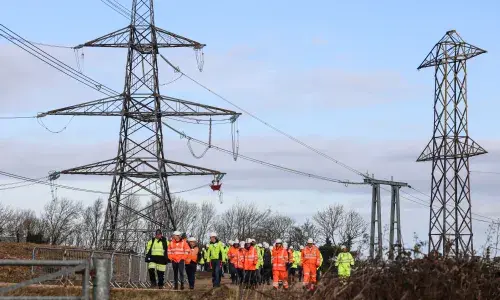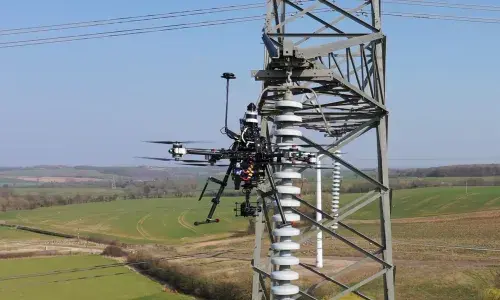
LCNI 2017: ETO’s powerful line-up
From a world-first testbed for new technology to eco-friendly gas alternatives, our Electricity Transmission Owner (ETO) business is plugging into LCNI 2017 with an impressive line-up of industry-defining innovations. Gemma Pead, ETO’s Innovation Stakeholder Officer, tells us more.
Here in Electricity Transmission, we’re committed to making innovation part of everything we do. We use it to prepare for the emerging challenges facing our industry and to create more value for consumers and society in a rapidly changing world.
Our electricity transmission network does a vital job. It connects hundreds of customers and, ultimately, millions of homes and businesses to the power they need. But we want to improve our network. And we’re finding new ways to run it faster, cheaper, greener and more flexibly than ever.
Our innovations are focused on four key areas. We aim to manage the life of our assets better, so we can reduce cost and disruption for consumers. We look for ways to provide new value as the electricity system evolves. We trial new materials, products and equipment to reduce the cost of building and managing new infrastructure. And we invest in new ways of working that help protect the world around us.
Much of our success in innovation is down to collaboration. We regularly work with stakeholders to explore new opportunities, and we team up with inspiring project partners to keep us at the forefront of innovation.
With collaboration so important, the Low Carbon Networks and Innovation (LCNI) Conference is always a highlight for us. It’s a great networking opportunity; a chance to meet everyone, from network operators to academic institutions, suppliers, generators and manufacturers, all under one roof.
We look forward to sharing some of our most successful innovation projects with you at the event at Telford’s International Centre on December 6-7. Here’s a snapshot of what you can expect to see:
Deeside
Project overview: We’re developing an innovation centre at Deeside that will soon help us speed up the implementation of new ideas and technologies into the electricity industry. A former operational substation is being converted to an offline testing facility. By mirroring a live substation, but working off-grid, we can test assets in real-life conditions, 24 hours a day, seven days a week. Over the next four years, we’ll be carrying out trials at voltages up to 400kV. The first phase of work focuses on overhead lines.
Benefits of this innovation: By testing new ideas in a real environment, we can put them into action on the system faster. In doing so, we’ll pass any savings they generate on to end consumers more quickly and improve the reliability and efficiency of the network.
What to expect at LCNI 2017: Visitors can view a detailed model of the future Deeside facility, talk to project experts, watch videos of the project and explore our dedicated website.
With collaboration so important to us in ETO, the LCNI Conference is always a massive highlight in our calendar.
– Gemma Pead, ETO’s Innovation Stakeholder Officer.
Mobile substation bay
Project overview: Substations play a vital role in the transmission and distribution of electricity throughout the grid. Mobile substations, which can be moved quickly to wherever they’re needed, provide flexible capacity that helps transmission owners manage security on the network and also helps connect new customers quicker. In this project, we’re designing and demonstrating a mobile substation bay that can be used on the 400kV transmission network. We’ve shown that the concept is feasible and can be successfully built.
Benefits of this innovation: Having a mobile solution that can operate at extra high voltages will make managing security of supply more cost-effective. These savings can be passed on to consumers.
What to expect at LCNI 2017: A model of the substation bay will be on the stand, videos will be playing and iPads will show the app we’ve developed to support the technology.
g3
Project overview: We’re trialling a novel alternative to sulphur hexafluoride (SF6) called Green Gas for Grid (g3). SF6 is an electrical insulator used widely in high-voltage electrical applications. Its downside is that it’s also a potent greenhouse gas. g3 is a new gas mixture that has the same technical benefits as SF6 but reduces carbon emissions by 98%. We’ve installed and pressurised g3 on two new sections of gas-insulated busbar (a bar found inside switchgear), making us the first transmission grid in the world to be using it on a 400kV network.
Benefits of this innovation: A 98% reduction in emissions makes g3 an ideal solution for a low-carbon future.
What to expect at LCNI 2017: Project partner and alternative gas expert Mark Waldron will be on the stand to turn this technical and detailed project into a simple and engaging story.
Portable earthing assist
Project overview: It’s essential to the safety of our technicians that they can earth any electrical equipment they’re working on. However, there’s not always a suitable earth switch at the point where they need to work. In those situations, they use a portable earth, but these are often difficult to install and can pose a risk to the person handling them. This project sets out to design, manufacture and test a new portable earthing assist device that potentially removes the majority of manual effort, therefore making it safer and more efficient to install and remove portable earths.
Benefits of this innovation: Making the earthing process more efficient will improve health and safety.
What to expect at LCNI 2017: Project Engineer Andrew Ridley will be on the stand to discuss the project and share his insights.
Alongside our activities on the stand, we’ll be presenting on the following projects:
- How MIDEL 7131, an insulating fluid in transformers, can reduce costs and benefit customers
- g3, an innovative SF₆ alternative for a low carbon future. Come and hear the latest learning from this hugely successful project
- Wind-exposed overhead lines – the latest research on our project to extend the life of these assets
- Digital substation, virtual site acceptance testing and training – what we’ve learned and where we are
- TRALC3 transformer ratings enhancements – how we’re using the latest tools to enhance capacity.
So there you have it. We’ll have lots to see and do, both on our stand and in breakout sessions. We’ve made excellent progress on a range of ground-breaking projects this year, and want to share and explore that with you.
I hope to see you at LCNI in December.


